Spending sometime at Subarnapur village , we moved along the river bank down stream to a place caller Kandarpur , approximately 10 kms away . A river island Amangei Kuda – stands another piece of marvel – Sri Paschimeswara Temple , early 10th Century built by the Keshari Dynasty . The place is unique and exquisite , if you plan to visit towards late afternoon , when the Sun is not hitting you hard. The boatman – Tulia who ferry visitors across the river, was also the care taker of this temple. However we couldn’t make it to this beautiful temple , as the motor malfunctioned , keeping us with another date for a visit to this special place.



Shibaji babu had to leave for some commitments at Bhubaneswar. The heat was sapping every bit of our moments , yet we made an attempt to visit Sri Bali Singhanatha – 9th Century , Grand Temple built for Lord Shiva. This is located on a river island in Mahanadi near village Gopinathpur , Badamba. A true stunning piece of Kalingan architecture , finely chiselled carvings and stories on the walls of the temple. The journey itself had made us forget the blazing summer heat . We navigated to where the Google pointed until we reached the banks of Mahanadi to see a temporary fair weather road for visiting this temple. We went in the vehicle to a where a temporary bridge has been made. Moment we walked on the bridge , the heat had disappeared , with the river gently flowing below.

A river island in Mahanadi . A temple built as early as 9th century or earlier , one of most mind blowing work of art . A Jewel box on Stone and amalgamation of Shaivism, Vaishnavism, Shaktism, Buddhism and Jainism. I was fascinated to see the place from the Ramnath temple , in Baideshwar in December. I could not wait until end of year. Top it all on one side is story of Ramayana and the other side Mahabharata carved to the details. All of us were just spell bound.

The temple has a rekhavimana and terraced roof jagamohana of transitional phase of temple style of Kalingan order. The temple is unique for its sculptural embellishment of both the Saivaite and Vaisnavite cult. The temple is of the panchayatana class though only the south-east corner shrine has survived. Several pidha shrines have been added in the compound at a later date which houses sculpture from the collapsed corner shrines.On the basis of architectural style like four mouldings pabhaga, incipient stage of pancharatha on plan and the decorative element, sculptural embellishment, iconographical feature assigned the temple to the 9th century A.D. The temple is richly carved with sculptural panel and decorative motifs.

Within the complex is Somanatha temple – It is a living temple and the presiding deity is a Sivalinga within a rectangular yonipitha, made of chlorite. The exterior of the temple is highly embellished with architectural motifs and sculptural motifs.

The mukhashala of the temple is rectangular , roof is flat, and pillared. The front portion of the wall some of the gorgeous carvings of the river goddess . Two distinguished broad bands were having the images of Saptamatrikas. On the left panel are Virabhadra, Maheshwari and Aindri. On the right are Brahmi Kaumari and Varahi with fish and bowl. Chamunda is seen squatting garlanded with skeletons.

Every year on the day of Dolo Purnima there is a Hari Hara Bheta i.e., meeting of Singhanatha and Jagannath at Badamba.

Almost dehydrated and famished for a meal , as we spent an hour inside complex running around the stone courtyard escaping the excessive heat . This place is a must visit , and I would look forward for another opportunity to visit this place along with our CHW members again . The locales and the heritage antiquities were breathtaking and unbelievable .


I lived in Cuttack for over 10 years and always eager to know our ancient heritage. One such thing is in Tulsipur. I can’t recollect the whole on the bank of Mahanadi river 6 to Seven temples are there with the Swaymbhu Samadhi of a Yogi who had been asked to eat beef by Sultan. ( Name forget) and one of the famous Akhara of India originated this places.
How the Tulsipur name originated.
Request your light on this.
I am writing this from Melbourne Australia.